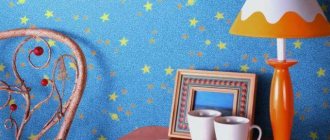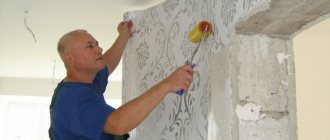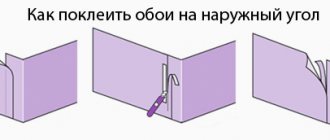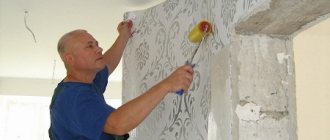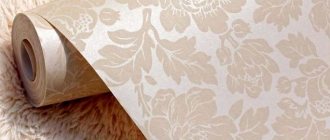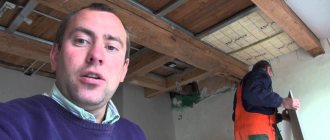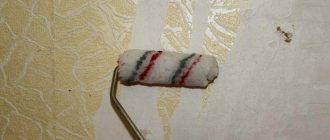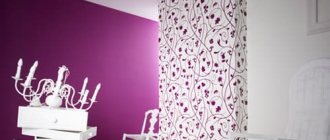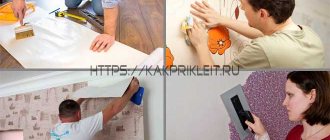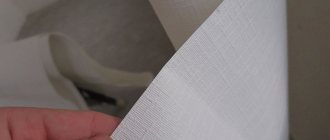Advantages of non-woven wallpaper
Non-woven wallpaper is based on a special two-layer material , one part of which consists of cellulose and the other of textile fibers. They are bonded together with a very thin layer of a polymer substance resembling glass wool. This composition has high performance characteristics that distinguish this type of coating from others. On sale you can find both plain embossed wallpaper, intended for subsequent painting, and colored wallpaper with all kinds of designs.
Wallpaper made from this material is deservedly popular, which is due to the numerous advantages of non-woven products . These include:
- High strength , especially when compared with paper wallpaper. When working with non-woven fabric, you don’t have to worry about the fabric tearing at the most inopportune moment.
- Stability. After drying, the material does not shrink, so the joints of the coatings will not separate under any conditions.
- Convenience at work. You only need to apply glue to the ceiling, leaving the canvas itself dry. This is very practical and allows you to cover a room alone.
- Great looks. Everyone can find a product with a suitable pattern that will transform any room.
- Practicality. Wallpaper for painting can be renewed several times, and when replacing non-woven coverings, it is enough to remove only the top layer, while the bottom will make the surface stronger and smoother and will facilitate the next pasting.
- Possibility of gluing on different types of ceilings - both wooden or concrete, and plasterboard.
- Durability. This product will easily last about 10 years.
- Easy to care for. A non-woven ceiling can only be vacuumed or wiped with a damp cloth from time to time.
Features of the material
Bedroom decoration
These are rolled materials made using non-woven fabric. First you need to understand what non-woven fabric is and what it is made of. This material is based on modified cellulose fibers, polyester and various specific additives.
During the production process, the liquid mass is stretched and takes the form of a tape, which is pressed and sometimes impregnated with glue.
Pasting the ceiling with non-woven wallpaper
Important! Each manufacturer keeps the composition of the non-woven fabric they produce secret, since its performance properties are directly related to internal components and modifiers.
The photo shows that the pattern of the canvas is selected in accordance with the color scheme and style of the room
Non-woven fabric has the following properties:
- Low moisture capacity;
- Excellent breathability;
- The material does not shrink after drying;
- The material has high abrasion and tear resistance compared to paper;
- Fire resistance;
- Resistant to stains and water-free paints.
It was these qualities that became the reason that the paper backing of the wallpaper was at one time replaced by non-woven wallpaper - then a roll of material appeared, called “non-woven wallpaper”.
Types of material
Gluing striped non-woven wallpaper onto the ceiling will help adjust the geometry of the room
The concept of “non-woven wallpaper” hides a considerable amount of rolled finishing materials that differ in appearance and performance properties. When dividing them, two main categories should be distinguished - completely non-woven material and fabrics with a non-woven base.
Pasting non-woven wallpaper onto the ceiling with a motley pattern
Fully non-woven fabrics are often perceived as an improved paper option. These are single- or multi-layer non-woven fabrics soldered to each other.
There are smooth or embossed canvases with a pattern embossed on the surface. Can be painted or have a factory-applied pattern.
Bathroom decoration
Rolled materials of the second category have a non-woven base and a decorative front layer made of paper, polyvinyl chloride or textile. In this case, the technical and operational properties of the material depend on the front layer. But regardless of the decorative coating, the non-woven base gives all these materials moisture resistance, vapor permeability and strength.
Non-woven ceiling wallpaper
Important! One of the positive qualities of such wallpaper is that the glue is applied not to the canvas, but to the base to which it is attached. Thus, the process of carrying out repair work is accelerated and simplified.
Pros and cons of non-woven wallpaper
Colorful interior design
We can safely say that non-woven wallpaper is characterized by all the positive qualities of paper roll materials, but due to the addition of polymers to their composition, they do not have the disadvantages inherent in paper.
Among the positive qualities of this material, the following can be noted:
- Due to the high density of the canvases, it is possible to hide some imperfections on the surface of the base;
- The material promotes air circulation but does not absorb moisture;
- Dust and dirt do not accumulate on its surface;
- When ignited, the material does not release toxins;
- The material is not subject to fading when exposed to direct sunlight;
- Such canvases are easy and quick to glue by applying the adhesive directly to the ceiling;
- The panels are glued end-to-end, but due to the fact that they do not stretch or shrink when dry, no gap is formed between the joints.
Decoration of the attic floor
Among the disadvantages of pure non-woven wallpaper, one can note their instability to mechanical stress - they are easily scratched and damaged by an accidental impact. Dust may accumulate on the textured surface of such wallpaper. The price for them is always high, since non-woven fabric is produced only outside our country.
Paper
Ceiling non-woven wallpaper with a paper top layer
Non-woven-based paper sheets have the lowest cost. They are environmentally friendly, and therefore are an ideal solution for a child's room or bedroom.
The disadvantages inherent in paper coating are leveled out thanks to various impregnations, which allow the material to withstand the effects of moisture and dirt for some time. This material can have from one to three layers. To obtain an interesting relief pattern, filler is introduced between the layers, and then the canvas is placed under a press.
Among the positive properties of such wallpaper, the following are noted:
- The material is environmentally friendly;
- Air permeability;
- The price of this material is lower than other varieties.
The disadvantages of this material include instability to mechanical damage and moisture. Such canvases have a smooth front surface, which means they do not hide the unevenness of the base well.
Vinyl
Bathroom interior design with moisture-resistant vinyl coverings
Among all the varieties of non-woven wallpaper, the most popular are those with a front vinyl layer.
The top polyvinyl chloride layer of this material is characterized by the following properties:
- Such canvases are not afraid of mechanical influences;
- Dust does not accumulate on their surface;
- They are easy to wash;
- Some varieties can be used in rooms with high humidity;
- The material is low cost;
- Canvases can have different textures and colors.
Among the disadvantages of non-woven wallpaper with vinyl coating, it can be noted that at temperatures from 110 to 120 degrees, vinyl ignites and releases toxins during the combustion process. The vinyl covering is monolithic and therefore does not allow air to pass through. The result may be condensation.
Modern manufacturers have learned to improve the quality of vinyl coating by providing it with micropores. When choosing rolled products, take into account the markings on the packaging indicating the air permeability coefficient.
Textile on non-woven basis
Non-woven wallpaper for the ceiling in the nursery
Textile wallpaper creates a stylish and elegant finish. Thanks to the non-woven base, their operating properties are increased. At the same time, the material retains its aesthetic appearance.
Textile fabrics can be velor, silk, linen, felt. This is the most expensive material.
Among the positive qualities, the following can be noted:
- The material has an impressive appearance;
- The coating turns out to be monolithic, since the joint between the strips is practically invisible;
- The material is environmentally friendly;
- It has sound and heat insulation properties.
Among the disadvantages, it can be noted that the fabric covering needs careful care; it absorbs odors and accumulates dust on its surface.
Canvases for painting
Non-woven wallpaper for the ceiling
Typically, rolled products for painting have a non-woven base. They are distinguished by a textured outer layer of white, cream or yellowish color.
Important! If paint is applied, the coating will lose its ability to pass air.
On the other hand, the paint layer masks the joints between the canvases and increases the strength of the material. One of the advantages of this type of finishing is the ability to paint the ceiling multiple times and create a new interior design without much effort.
Non-woven wallpaper on the ceiling can be painted with water-based, acrylic and latex compositions. Each of the listed types of dyes imparts certain properties to the canvases. Thus, the latex coating is resistant to moisture and treatment with detergents.
There are several ways to paint such wallpaper:
- Complete roller painting of canvases previously glued to the ceiling. If the canvas has a relief, then it is painted using a short-haired tool - this method allows you to obtain a three-dimensional pattern;
- You can paint rolled products from the back side so that the paint is absorbed into the non-woven base and the design remains intact;
- To get a delicate pastel shade of wallpaper, first paint the ceiling and then cover it with wallpaper. In this case, the paint will shine through, giving the wallpaper the required tone.
Important! Canvases can only be painted after they are completely dry. This will take about 24 hours.
If roll products are initially factory-colored, they can be repainted in dark colors. Rare expensive materials include rolled products with metallized, bamboo, reed, and reed front layers.
Preparatory activities
Before gluing non-woven wallpaper to the ceiling, you must first prepare it properly. High-quality preparation will guarantee that the pasting process will go faster and the wallpaper will last longer. Here are the features of work on different types of ceilings:
- If whitewash with lime or chalk has been applied to the surface , it must be thoroughly washed off with warm soapy water using a rag or brush. If the whitewash layer is thick, you should use a spatula to remove it, and then remove the remaining chalk with water.
- There is no need to wash off oil-based or dispersion paint from the ceiling before pasting. The main thing is that it does not crumble, because this will prevent the wallpaper from holding firmly in the future. To check how well the paint is set, just attach a strip of tape to the ceiling and then quickly tear it off. If the tape is clean, you can start gluing, having first cleaned the surface of dust. Otherwise, you will have to get rid of the paint.
- Concrete or plastered ceiling surfaces must be leveled. All deep cracks should be filled with putty, dried, sanded and primed. Small irregularities can be left, because non-woven fabric is a fairly dense material that can smooth out minor imperfections on the surface to be pasted.
- The plasterboard ceiling requires the most work. It is necessary to smooth out all the joints between the plates and the places where the screws are attached. This is done using putty and reinforcing tape. After drying, the areas are leveled with sandpaper and primed. Next comes the stage of finishing putty over the entire coating area, which can be skipped if the plasterboard boards are of a light shade. As for priming work before gluing, it must be carried out very carefully, since if it gets too wet, the drywall may delaminate.
- In wooden houses there are ceilings made of OSB and plywood. You can also stick non-woven wallpaper on them. The main thing is to remove any existing irregularities, and cover the OSB surface with starting and finishing putty and prime it. On plywood, you can simply smooth out the joints and apply a primer after drying.
Advantages of finishing the ceiling with wallpaper
Non-woven wallpaper for ceilings
The choice of such a ceiling finish is often associated with its following advantages:
- Low cost of material;
- An easy way to carry out repair work that does not require professional skills and expensive tools;
- Fast and relatively “clean” ceiling design process;
- Maintaining the height of the room;
- Ability to hide minor base defects;
- The ability to combine materials for visual zoning of a room and adjusting its geometric parameters due to optical effects;
- The ability to paint some types of wallpaper allows you to change the color scheme in the interior.
Non-woven ceiling wallpaper
The disadvantages of rolled materials are usually:
- Zero or low moisture resistance;
- Instability to steam, odors and direct sunlight;
- Rapid contamination;
- The need to prepare the base to obtain a flat surface.
However, it is worth noting that among the huge selection, you can choose the type of roll materials that can be used in the proposed conditions.
Calculation of material quantity
Before pasting, you should calculate the required number of rolls to purchase. It depends on the area of the room where the repair will be carried out, and also on the width of the product. The length of one roll of wallpaper is 10.5 m, and the width can be either 53 or 106 cm. It is faster and more practical to glue meter-long non-woven wallpaper to the ceiling.
First you need to determine the required strip length. To do this, you need to decide how to hang the wallpaper - lengthwise or crosswise. It is more convenient to place stripes along the short side of the room. It is very good if they are located perpendicular to the wall in which the window opening is located. Depending on the decision made, the length of one strip should be a distance equal to the length or width of the room, to which 10-15 cm is added for possible trimming.
Next, the number of stripes is calculated. To find out, you should divide the distance of the side along which the pasting will be made by the width of the wallpaper and round up. After such calculations, it will not be difficult to understand how many strips will come out of one roll and determine the required number.
Stages of work
After completing all the preparatory work and purchasing the material, you can begin gluing the ceiling. First you need to remove all the lamps from it and close the windows to prevent the formation of drafts. Since wallpaper is measured and cut on the floor, it must be clean and dry.
Preparing the adhesive solution
Non-woven wallpaper requires special glue . Therefore, when choosing it, you should pay attention to what products this or that type of glue is intended for. The types with coloring pigments are very convenient to use. This way you won’t be afraid to miss any area when applying glue to the surface.
The adhesive solution must be prepared in strict accordance with the attached instructions. Some experts even recommend taking a little less water than the manufacturer advises. This will make the solution thicker and enhance its adhesive properties.
Pasting process
Many people who are planning to do ceiling papering for the first time consider the work ahead to be very difficult. This is not at all true, because the ceiling surface is usually much smoother than the walls, and besides, there are no extra openings, corners and a large number of sockets that interfere with the process. But in this case you will still need an assistant.
The gluing process itself consists of the following steps:
- Markings are applied to the ceiling. To do this, the width of the wallpaper is marked at both ends, and then they are connected with a cord along which a line is drawn with a pencil or chalk;
- The roll is rolled out face down on the floor. The distance corresponding to the required length of the strip is marked on it. If you choose wallpaper with a large pattern, it must be lined and each stripe must be numbered. It is better to cut a piece using a sharp stationery knife;
- Glue is spread evenly onto the ceiling. This can be done using a paint brush or a roller with a long handle;
- the cut strip is aligned with the markings and pressed tightly against the surface. If 2 people are working, one holds the end of the strip, and the second does the gluing. When the worker is alone, the strip should be rolled up, one end glued, and then, gradually unrolling the roll, move to the opposite side;
- the panel is carefully smoothed with a spatula or rubber roller to remove air bubbles and get rid of wrinkles. Movements are made from the center to the edges;
- the wallpaper is wiped with a soft cloth to eliminate traces of glue;
- the strips are glued end to end;
- At the point where the lamp is located, a cross-shaped cut is made through which the wires are brought out. After they are removed, the panel is pressed firmly along the edges of the incision. The decorative box of the chandelier will make it invisible;
- Excess wallpaper is cut off with a sharp knife, running it along a ruler or spatula tightly pressed to the surface. Trimming can be done both after gluing each strip, and at the end of the work.
After completing the work, you should wait until the wallpaper is completely dry, without opening windows or connecting lamps. In winter, it is recommended to cover the batteries with a slightly damp cloth, otherwise the glued panels may fall off.
Ceiling painting
If you purchased wallpaper that requires subsequent painting, you should start it only after the ceiling is completely dry. As for paint, dispersion, latex and water-based types are suitable. The shade depends on the preference of the owner of the room, but it is better to choose more delicate pastel colors. This is especially true for rooms with low ceilings.
It is recommended to apply the paint with a short-nap roller. You need to do this 2 times. The first layer is applied perpendicular to the wall with the window, and the next layer is applied parallel to it. This method of painting ensures that there are no noticeable stripes on the ceiling. If there are decorative elements on the ceiling surface, they should first be attached to a permanent place and painted with a brush. Painting wallpaper and elements must be done at the same time.
A ceiling covered with non-woven wallpaper will not require large expenditures and will please its owner for a long time.
Painting wallpaper for the ceiling
Since non-woven wallpaper is initially white, it can be painted any color. It is worth remembering that this is still a ceiling, and dark and rich shades are unlikely to look appropriate on such a surface. Acrylic or latex paint is suitable for painting. You need to add color to it in advance. If you plan to paint large areas, it is best to have the composition tinted in a special salon. Only in this case, when it dries, you will get the same shade everywhere. The paint is best applied with a medium to short nap roller. This will help distribute the composition more evenly and thoroughly over the wallpaper. The paint dries completely after 2 hours. For uniform coverage, two coats must be applied. Thus, you should not frighten yourself with the question: how to properly glue and paint wallpaper on non-woven fabric. You just need to get to work, and it will immediately become clear what a convenient material it is.
Related publications
- An easy way to beautifully cover a ceiling
- Which wallpaper for painting should I choose for the ceiling?
- Liquid wallpaper for finishing the ceiling in the kitchen
- How are two-level stretch ceilings installed?
Click to cancel reply.
